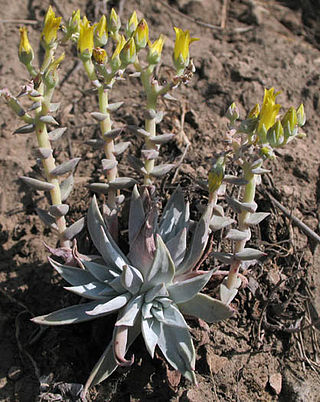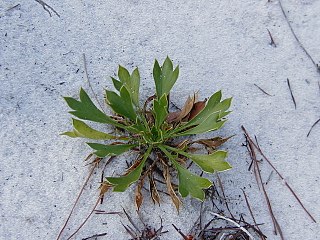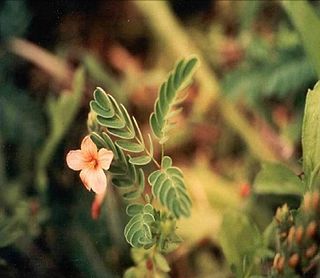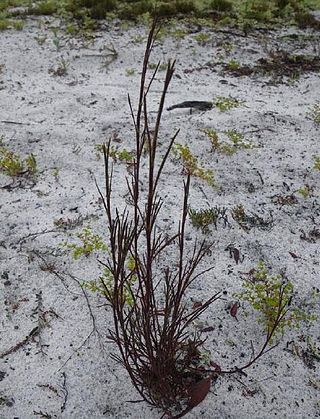
Eryngium maritimum, the sea holly or sea eryngo, or sea eryngium, is a perennial species of flowering plant in the family Apiaceae and native to most European coastlines. It resembles a thistle in appearance because of its burr-shaped inflorescences. Despite its common name, it is not a true holly but an umbellifer.

Eriodictyon capitatum, the Lompoc yerba santa, is a rare evergreen shrub in the borage family. It is endemic to western Santa Barbara County, in California.

Eryngium aristulatum, known by the common names California eryngo and Jepson's button celery, is a species of flowering plant in the family Apiaceae.

Eryngium armatum, known by the common names coastal eryngo and prickly coyote thistle, is a species of flowering plant in the family Apiaceae.
Eryngium constancei is a species of flowering plant in the family Apiaceae known by the common name Loch Lomond button celery, or Loch Lomond coyote thistle. It is endemic to California, where it is known from only three occurrences north of the San Francisco Bay Area. One of the populations is at the Loch Lomond Vernal Pool Ecological Reserve at Loch Lomond in Lake County. The plant appears mainly in vernal pools. It is endangered on the state and federal levels.
Erysimum teretifolium is a species of Erysimum known by the common names Santa Cruz wallflower and Ben Lomond wallflower. It is a very rare plant endemic to Santa Cruz County, California, where it grows on inland sand spits, chaparral, and sandstone deposits in the southern Santa Cruz Mountains. It is a California state and federally listed endangered species.

Arctostaphylos montaraensis, known by the common name Montara manzanita, is a species of manzanita in the family Ericaceae.

Brodiaea filifolia, known by the common name thread-leaved brodiaea, is a rare species of flowering plant in the cluster-lily genus. It is endemic to southern California, mostly in the region around the junction of Orange, Riverside, and San Diego Counties.

Chorizanthe cuspidata is a species of flowering plant in the buckwheat family known by the common name San Francisco spineflower. It is endemic to California, where it is known only from the San Francisco Bay Area and to the immediate north and south. It grows in sandy coastal habitat.

Dudleya verityi is a rare species of succulent plant known by the common name Verity's liveforever. It is endemic to Ventura County, California, where it is known from only three occurrences in the vicinity of Conejo Mountain between Camarillo and Thousand Oaks. It probably occurs in a few additional locations nearby which have not yet been officially vouchered.
Eryngium pinnatisectum is an uncommon species of flowering plant in the family Apiaceae, known by the common names Tuolumne eryngo and Tuolumne button celery.
Eryngium racemosum is a rare species of flowering plant in the family Apiaceae known by the common name delta eryngo, or delta button celery.

Lilium maritimum is a species of lily known by the common name coast lily. It is endemic to California, where it is known only from the coastline north of San Francisco. It formerly occurred south of San Francisco, but these occurrences have all been extirpated. The species is now restricted to the North Coast from Marin County to Del Norte County, and is most common in Mendocino County. It grows in the California coastal prairie habitat, coniferous forests, and bogs amongst Drosera species.

Bloomeria clevelandii is a rare species of flowering plant that is known by the common name San Diego goldenstar. It is native to a strip of scrub and coastal grassland in San Diego County, California, and adjacent Baja California. Genetic analysis of several morphologically similar genera shows that this species, which was named Muilla clevelandii for several decades, is not very closely related to the other members of Muilla and is moved back to Bloomeria.
Trifolium buckwestiorum is a rare species of clover known by the common name Santa Cruz clover.
Monardella stoneana is a rare species of flowering plant in the mint family known by the common name Jennifer's monardella.

Eryngium cuneifolium is a rare species of flowering plant in the carrot family known by the common names wedgeleaf eryngo, wedge-leaved button-snakeroot, and simply snakeroot. It is endemic to the state of Florida in the United States where it is known only from Highlands County. It is one of many rare species that can be found only on the Lake Wales Ridge, an area of high endemism. It was federally listed as an endangered species of the United States in 1987.

Hoffmannseggia tenella is a rare species of flowering plant in the legume family known by the common name slender rushpea. It is endemic to Texas, where it is known from only two counties. It persists in small remnants of its gulf coastal prairie habitat. It is a federally listed endangered species of the United States.

Hypericum cumulicola is a rare species of flowering plant in the family Hypericaceae known by the common name highlands scrub hypericum, or highlands scrub St. John's wort. It is endemic to Florida, where it is threatened by habitat loss and degradation. It is a federally listed endangered species of the United States.

Polygonum basiramia is a rare species of flowering plant in the knotweed family known by the common names wireweed, hairy wireweed, purple wireweed, and Florida jointweed. It is endemic to Florida in the United States, where it is limited to the central ridges of the peninsula, including the Lake Wales Ridge. It is threatened by the loss and degradation of its habitat. It is a federally listed endangered species of the United States.















